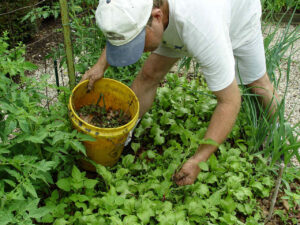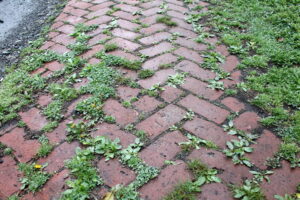The Case for Weeds
August 29th, 2023
Had enough of yanking weeds this season?

Is this always necessary?
No matter how good or bad a growing season turns out, weeds always seem to thrive.
But that’s one of the traits that makes weeds such survivors – they’re pretty good at rolling with whatever punches nature (and gardeners) throw at them.
Rather than curse weeds in our never-ending attempt to eradicate them, maybe a better idea is to tolerate them – and maybe even (horror!) welcome some of them into the landscape.
That’s the view of Harvard urban biologist Dr. Peter Del Tredici, whose message has been roundly drowned out lately in a time when weeds – and most any non-native plant, for that matter – are considered to be an evil green blight.
Del Tredici, on the other hand, argues that most of these maligned plants offer more redeeming traits than not.
He’s not even a fan of the word “weed.” He prefers the more non-judgmental term “spontaneous vegetation.”
I first heard Del Tredici at a conference in 2012, two years after he wrote a book called “Wild Urban Plants of the Northeast,” which laid out a controversial counterpoint to what was then a brewing native-plant movement.
He made some very sensible points about weeds (sorry, “spontaneous vegetation”) that caused me to rethink my view.
Now before all of you weed-haters and native-plant supporters stop reading, note that Del Tredici doesn’t advocate purposely planting invasives.
What he does advocate is that we ought to stop separating plants by “good” or “bad” and instead look at each based on its pros and cons in a particular setting.
It boils down to this. We can either: 1.) label certain plants as undesirables and spend a lot of time and effort trying to eradicate them, or 2.) accept that some “spontaneous vegetation” might actually be best in some spots (or at least not worth killing).
In other words, does it sometimes make more sense to go with the hand we’re dealt?
“You may not like them, but that’s irrelevant,” Del Tredici said at that 2012 conference. “These plants are sometimes just best adapted to the conditions we’ve given them.”

This hollyhock seems to be satisfied with the location it’s picked.
He argues that urban and even suburban landscapes are nothing like the ecosystems that were here before townhouses and parking lots.
“No plants are native to that,” Del Tredici says. “These are manmade environments.”
Toss in the always-growing lineup of new bugs and new diseases, our increasingly erratic weather, and changes in animal grazing (especially deer), and it’s obvious we’re not dealing with our forefathers’ landscape.
Instead of forested land with loamy soil undisturbed after hundreds of years of leaf drop, most of us live on land that’s been stripped of all vegetation, bulldozed, and topped with six inches of clay or shale from the stored pile.
While it may seem worthy to replant with “native” plants, it’s not that simple, Del Tredici argues.
For one thing, he says “native” is an arbitrary term that’s based on time frames and political boundaries. Ecology doesn’t distinguish, for example, whether a plant arrives by wind, water, or bird (“natural”) vs. nursery pot, 747 jet, or plant geek (“exotic invader”).
Second, introduced and spontaneous plants often perform better than plants that were here 300 years.
“Change always brings winners and losers,” says Del Tredici. “The idea that we can turn the clock back and restore the landscapes of the 1800s, to my way of thinking, it’d be easier to restore the economy of the 1800s. It’s just a different place now.”
Especially in urban areas, up to 40 percent of the landscape goes untended. This is the land of neglected rights-of-way, rocky banks, roadside ditches, rusty chain-link fences, abandoned lots, construction rubble, and gravel alleyways.
It’s no wonder the gap is being filled by durable pokeweeds, trees of Heaven, Oriental bittersweet, and thistle.
Not so coincidentally, much of this fare is native to environments similar to the harsh man-created settings they’re colonizing – namely, cracks in cliffs and outcroppings, gravelly riverbeds and hot, open meadows.

This part of a yard doesn’t look anything like its “native” state. Dandelions and plantain seem to like the new environment.
“You can talk about what used to grow here,” says Del Tredici. “But to talk about what’s native once an area has become urbanized doesn’t make much sense.”
He says non-natives get a bad rap for “displacing” native vegetation when, in fact, we’ve already displaced that vegetation with asphalt and lawn and changed the playing field to suit the newcomers.
He adds that relatively few have turned out to be really horrid invaders (kudzu, mile-a-minute weed, and giant hogweed are three that come to mind).
Like it or not, says Del Tredici, most of these opportunists are giving us some benefit in exchange for their grievances, which usually boil down to aesthetics (“Look at that weedy mess!”) and sanitation (potential harbors for trash, ticks, rodents, etc.)
On the plus side, “cosmopolitan urban vegetation” (another Del Tredici term) provides these ecosystem services:
* Provides shade and reduces urban temperatures.
* Absorbs runoff and breaks down toxins in water.
* Slows erosion and stabilizes soil on slopes and stream banks.
* Gives habitat to urban/suburban wildlife.
* Filters air while producing oxygen.
* Sequesters carbon, a particular benefit in urban air that’s typically higher in carbon dioxide than non-urban air.
Those benefits come with no up-front planting cost, no spraying, no watering, and no maintenance.
“Spontaneous landscapes are highly sustainable,” Del Tredici says.
However, he has no illusion that people soon will embrace dandelions as admirable plants, even given the budget savings and environmental wisdom of dialing down on Roundup and gas-powered weed whackers.
What we may need to do, though, is be a bit more forgiving of nature’s solution until we come up with – and are willing to pay for – a better idea.
If you’re interested in more about what Del Tredici has to say about weeds and non-natives, the second edition of his $34.95 “Wild Urban Plants of the Northeast” is now in print from Cornell University Press. The book is an excellent field guide of weeds, too.
If you’d rather watch than read, Del Tredici has a PowerPoint program based on his book on YouTube.







